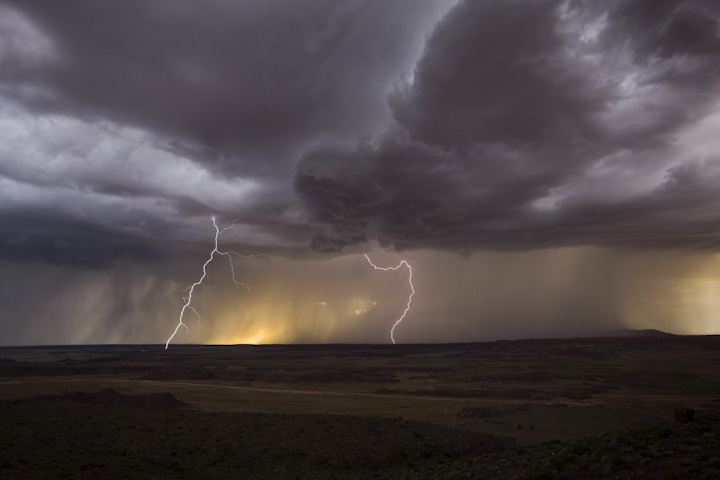
As I’ve said before, I’m an enormous fan of photographing in bad weather, stormy weather often creates dramatic conditions, and lightning can be an incredible element in such scenes-if you can capture it-lightning is incredibly difficult to capture, even more so to capture well.
Before I start discussing how to photograph lightning, a few short words about safety. Safety is, of course a serious concern, you’ll want to photograph lightning from a distance, preferably miles from the storm, and preferably not on an exposed point. This post won’t, and can’t cover every aspect of lightning safety, be sure to learn how to protect yourself before you go shooting-no photograph is worth risking your life for.
The first task in shooting lightning is to be where the lightning storms are. I live in the San Francisco Bay Area, and storms with lightning are fairly rare, so if I want to shoot lightning I’ll be travelling, often to the American Southwest during July and August, the “monsoon season”, where afternoon and evening thunderstorms can be a daily occurrence.
Night provides the easiest opportunities to capture lightning, since the lightning itself will provide all (or most) of the light in the scene, it’s just a matter of making sure that the shutter is open when the lightning strikes, using a long exposure time, just start taking an exposure on “bulb” and then stop the exposure once there’s been a flash of lightning. For digital cameras, you’ll want to understand how long of an exposure your camera and still get clean results, some digital cameras may have trouble taking, say, a ten-minute exposure without introducing a fair bit of noise. You’ll want a moderate aperture (start with f/8, but it’s hard to give good guidelines here, experiment, but f/8 isn’t a bad starting point) and a composition that enables you to work at that aperture and keep both the lightning itself and any landscape you include in the shot in focus.
Daytime shots are a much bigger challenge. Downward lightning usually begins with a really beautiful branching arcs as the lightning attempts to “find ground”, once a path is found, this is followed by a short series of strokes down a single path. All of this happens in as little as a half a second, the best branching happens first for a very short period of time, the best you can usually hope for in daytime is catching those later singular strokes. And we’ll have to settle for short exposures, we can’t just leave the shutter open. The only plausible way to consistently capture daytime lightning is to trigger the camera based on the lightning, either by hand or automatically, that’ll often allow us to capture those later strokes. You’ll want to use manual exposure with a shutter speed around 1/4 second, much longer than this and the lightning will show dim compared to the rest of the scene, much shorter and you’re likely to miss one of the substrokes. Manual exposure (and focus) will allow your camera to fire more quickly once the shutter release is pressed.
Hand capture is very tricky indeed, it requires video-game style reflexes, usually with the shutter half-pressed already. I can’t manage it consistently, instead I’ve had excellent success with the Lightning Trigger from Stepping Stone Products, which I’ll be reviewing here tomorrow.